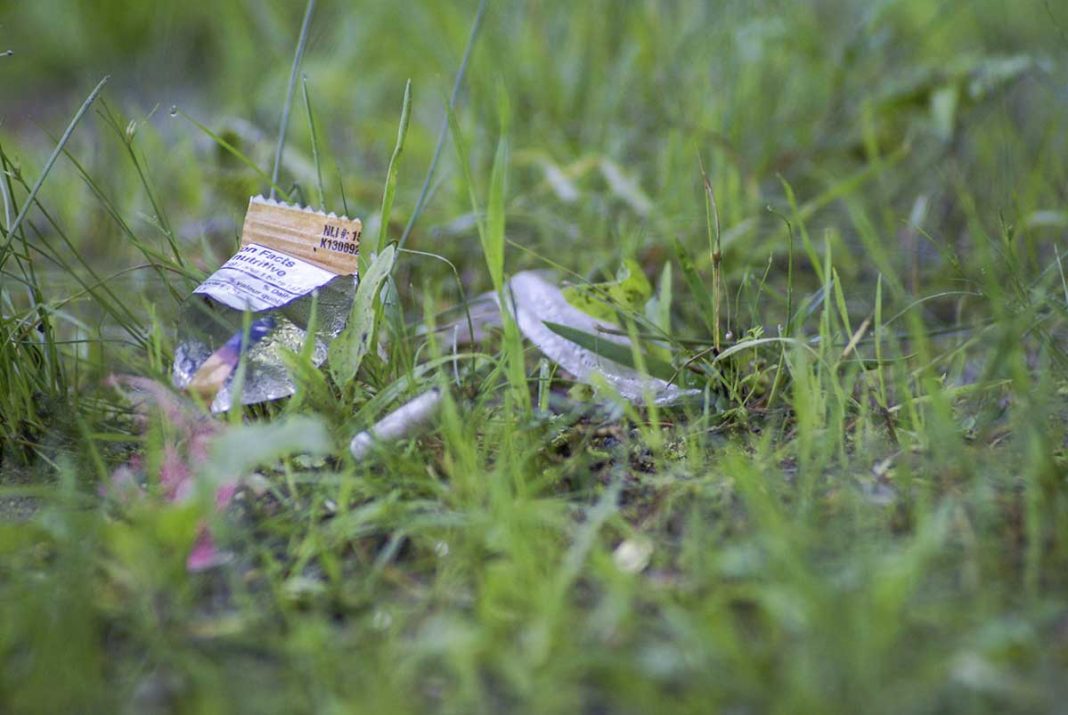Laundry microfibres a major source of microplastics found in freshwater, research ongoing
MANITOULIN – When Dr. Michael Rennie began researching microplastics in Lake Winnipeg back in 2014, he was surprised to find levels that were comparable to those in some of the Great Lakes. More recently, Dr. Rennie has been conducting research on microplastics at the Experimental Lakes Area (ELA) in Northwestern Ontario and last year did background sampling on several ELA lakes, finding evidence of microplastics even in that very remote area.
Plastic production and the use of plastic has been increasing since the 1950s and plastic waste has become an important environmental issue. A 2020 report estimated that one percent of plastic waste enters the environment in Canada, which accounted for 29,000 tonnes of plastic pollution in 2016.
Microplastics have been found in the Great Lakes on shorelines and in surface water and lake floor sediments, said Samantha Bayard, spokesperson for Environment and Climate Change Canada. Overall, plastic pollution negatively impacts ecosystems, entangles or is ingested by wildlife and burdens livelihoods including industries such as tourism and fisheries and communities responsible for managing the pollution. More research is needed to determine the effects of plastic pollution, including microplastics, in the Great Lakes.
Dr. Rennie agrees. While there is considerable research into the effects of microplastics on the marine environment and there are insights to be gained by looking at the marine literature, more needs to be done specific to freshwater, he said. There are qualities to freshwater that make these investigations a little more relevant. “This is where we get our drinking water from and often where our wastewater is received, particularly in Canada’s inland regions, so understanding the impact of microplastics in freshwater is potentially more relevant in understanding the decisions we make and the policies we make in terms of impact on the ecosystems and how they affect us ultimately.”
Dr. Rennie, along with Chelsea Rochman from the Rochman Lab at the University of Toronto and Diane Orehil from Queen’s University, are two years into a microplastics experiment at ELA. The main goal of the study is to help them understand at what concentrations they start seeing ecosystem level impacts. “We’re trying to raise those concentrations in terms of low to high and what’s relevant in terms of what you’d find in the environment,” said Dr. Rennie. Ideally they’d use that information to guide a whole lake experiment that is scalable. Plastics can disintegrate in the sun and chemical compounds found on microplastics can leach into the water and can have potentially negative impacts on aquatic life. “We don’t really know what the ecological consequences of (microplastics) are. Does it just get buried in the sediment and that’s it? Or are there actual measurable responses to microplastic exposure to the ecosystem and biota that are supported by the ecosystem?”
“One of the things that ELA research has really been able to demonstrate over the years is not just the direct impacts (exposing this organism to this concentration does this) but also indirect effects so when one organism respond how does the response of that one piece of the food web affect other pieces of the food web that might not be responding directly to microplastics but might instead be responding to the loss of a species or a reduction in abundance or slower growth rates,” he said. “That’s where the whole ecosystem approach becomes really valuable instead of just running beaker based experiments in labs.”
Lisa Erdle is a Ph.D. student at the Rochman Lab where she has been specifically looking at microplastics in fish. She was finding a lot of microfibres so her research has focused on microfibres that shed from our clothing and what their effects are to aquatic species. Rochman Lab researches plastics from polystyrene to polyethylenes, looking at its prevalence in the Great Lakes, its prevalence in drinking water and then starting to understand what the effects are to different species. Some of Ms. Erdle’s work involves looking at fish from Lake Ontario and Lake Huron.
Microfibres that shed from clothing during laundering are a significant source to waterbodies. A 2019 report by Ocean Wise in Vancouver estimated the average Canadian household releases 533 million microfibres from laundry every year and an estimated 878 tonnes of microfibres are released to water following wastewater treatment in Canada and the United States every year. “Before I started my work I had no idea that a single load of laundry could release hundreds of thousands of microfibres,” said Ms. Erdle. Washing machines are set up so they can monitor items of clothing or other garments and see how much they shed. “One of our research areas is to look at solutions. We know that there’s a large amount of shedding, can we capture those microfibres?”
The answer is yes. Different devices were tested in the lab, including the Lint LUV-R washing machine filter that captures all the effluent from your washing machine and a device called the Cora Ball. She found that the washing machine filter is very effective and captured up to 90 percent of the microfibres in a single load of laundry while the Cora Ball captured roughly 26 percent, often smaller fibers. Working together these two technologies can be an effective way to reduce
emissions to the environment, according to the report. “That’s important because most of the microfibres that leach through washing are going to end up in the environment,” she said, “so we are really interested in capturing them at the source. I had no idea how many microfibres are coming out of your wash before I started. I never realized that microfibres are kind of like the lint fibers that are captured in the dryer.”
There is some work that has looked at different washing machines, like top loader versus front loader, and there are shedding differences but it’s still not clear whether laundry detergents or fabric softeners make a difference. Ms. Erdle noted recent research by Proctor & Gamble that shows there is a significant temperature difference so washing in cold water, washing smaller loads and shorter load cycles all contribute to less shedding of fibers.
Microfibres not captured by filters are released with wash water where they are sent to wastewater treatment plants. In most treatment facilities, the fibers will get captured in the solids that are then applied as fertilizers because they’re very rich in nutrients. If the plants aren’t directly releasing microfibres into the environment they’re indirectly releasing them through applying the sludge on agriculture fields, Ms. Erdle said. “We also do see it in the final effluent at the plant. Research on the Great Lakes shows that a single wastewater facility can release in the upwards of millions of microfibres in a single day.”
Millions of microfibres would fill several buckets. It doesn’t sound like much but buckets add up. A 2019 report by Pollution Probe and Clean Water Foundation noted there were 1,448 water treatment facilities distributed around the Great Lakes, discharging more than 18,000 million litres of water per day.
“What we see from previous research is the effects on fish can be different but some research shows that these microfibres can effect things like growth, they can affect physical characteristics such as the size of the liver in relation to the rest of the body,” she said. “In our lab we’re looking at what the effects are to different Great Lake specific species. Most of the work has been done on species that are not in the Great Lakes and I’ve noticed that microfibres are the most common microplastic type in the Great Lakes.”
She’s curious about what it means for the species that live there. “The microfibres are so small and lightweight. They can be carried on air currents so they can be deposited in northern regions. You have air rising and then you have air falling in the Arctic and that air is probably carrying microfibres.”
She is also testing natural versus synthetic microfibres, with and without chemical contaminants and with different species of fish and invertebrates, to see what those effects are. Cotton will eventually break down in the environment but this can be influenced by things such as chemicals. Even a cotton t-shirt can contain chemicals, dyes or finishes; those chemicals might impact how natural fibers are broken down in the environment. Since natural fibers might contain one-third chemicals by weight that likely will impact how long it takes to break down.
“I have fish that I’ve raised since eggs and we’re raising them for their full lifecycle. We’ll be looking at their offspring and seeing if there’s any generational effects as well,” she said. The experiment will wrap up later this summer or early this fall with initial results expected in the fall.
Her current work is supported by the Department of Fisheries and Oceans (DFO), in collaboration with Ministry of the Environment and Climate Change (MOECC) and Environment Canada and Climate Change (ECCC).
Canada has set a target of zero plastic waste by 2030. The plan includes working with provinces, territories and all stakeholders to implement this agenda to keep plastic in the economy and out of the environment. In addition to addressing single-use plastics, the federal government will be investing in science, innovation and community action; working with partners to improve product design so that items can be repaired, last longer and be recycled; developing markets for innovative products and those that have recycled content; and finally, making producers responsible for the waste their products generate. Actions by individuals, communities and industry can also make a big difference, said Ms. Bayard.
Other initiatives supported by the federal government include the Zero Plastic Waste Initiative and the prohibition of the manufacture, import and sale of all toiletries containing plastic microbeads as of July 1, 2019.





